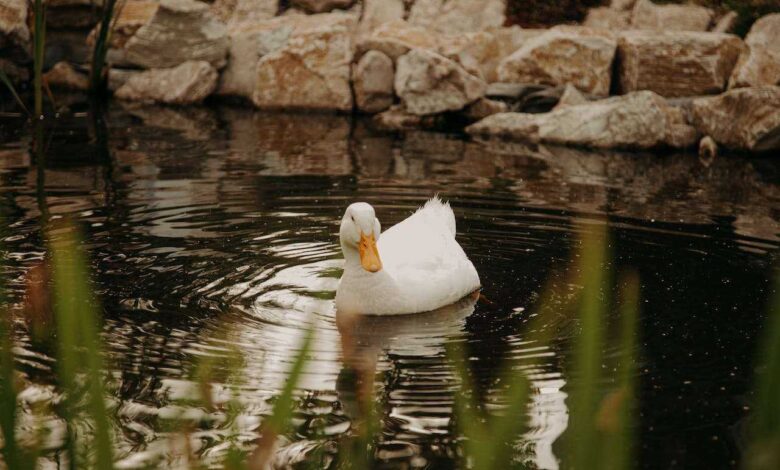Creating a Duck Pond: How to Build a Tranquil Oasis

Creating a duck pond is a delightful project that enhances the well-being of your feathered friends while adding charm to your property. This comprehensive guide walks you through the essential steps to create a safe, enjoyable, and aesthetically pleasing pond for your ducks.
Planning Your Duck Pond
Factors to Consider for a Functional Duck Pond
Embark on the journey of building a duck pond by thoughtful planning. Consider the number of ducks, available space, and local regulations. Calculate the ideal pond size, choose a location that balances sunlight and shade, and plan for the integration of natural elements.
Planning essentials:
- Pond size and depth: Calculate based on the number and size of your ducks.
- Location considerations: Choose a spot with ample sunlight, away from overhanging trees to prevent debris.
- Natural elements: Plan for aquatic plants and rocks to enhance the pond’s ecosystem.

Selecting Pond Design and Shape
Choosing Based on Aesthetics and Functionality
Delve into various duck pond designs, from natural, wildlife-friendly ponds to more formal, landscaped options. Consider the surrounding landscape, your ducks’ preferences, and your maintenance capabilities. Tailor the design to harmonize with your backyard and provide a safe and enjoyable space for your ducks.
Pond design options:
- Natural wildlife pond: Mimics natural habitats, promoting biodiversity.
- Formal landscaped pond: Offers a controlled and aesthetically pleasing environment.
- Hybrid designs: Combining elements for both visual appeal and ecological balance.
Essential Features for a Functional Duck Pond
Creating a Duck-Friendly Environment
Ensure your duck pond is functional and safe by incorporating essential features. Install a water filtration system to maintain water quality, protect the shoreline with rocks or plants, and provide floating platforms for your ducks to rest and preen. Prioritize their safety and enjoyment.
Functional pond features:
- Water filtration system: Maintains water clarity and quality.
- Shoreline protection: Prevents erosion and provides a safe habitat.
- Floating platforms: Offers resting spots for ducks and encourages natural behaviors.
Excavation and Pond Construction
Ensuring Durability and Longevity
Move on to the construction phase by excavating the pond and shaping its contours. Different materials, such as liners, rocks, and gravel, offer various benefits and drawbacks. Consider the local climate and your budget when making construction decisions, aiming for a durable and visually appealing pond.
Excavation and construction:
- Liner options: Choose between rubber, PVC, or concrete liners for your pond.
- Rocks and gravel: Enhance the pond’s natural appearance and provide habitat for beneficial microorganisms.
- Budget considerations: Balance aesthetics and functionality within your budget.

Pond Filtration Systems
Ensuring a Clear and Healthy Pond
Focus on maintaining water quality by installing a suitable filtration system. Mechanical filters remove debris, while biological filters support beneficial bacteria that break down organic matter. Select a system that matches your pond size and duck population, ensuring a balanced and healthy ecosystem.
Pond filtration options:
- Mechanical filters: Remove debris and solid particles from the water.
- Biological filters: Promote the growth of beneficial bacteria that break down organic matter.
- UV clarifiers: Control algae growth and maintain water clarity.
Landscaping Around the Duck Pond
Enhancing the Beauty and Functionality of Your Pond
Optimize the surroundings of your duck pond by incorporating landscaping elements. Select native aquatic plants to oxygenate the water and provide hiding spots for small creatures. Use rocks and edging to create a visually appealing pondscape that blends seamlessly with your backyard.
Pond landscaping considerations:
- Aquatic plants: Choose native species that benefit the pond’s ecosystem.
- Rocks and edging: Create a natural transition between the pond and the surrounding landscape.
- Safety measures: Ensure landscaping elements do not pose risks to your ducks.
Creating a Duck Pond
Creating a duck pond requires thoughtful planning, attention to detail, and a commitment to ongoing care. By following this guide, you’ll create a haven where your ducks can thrive, ensuring both their physical and mental well-being. Happy pond building!

FAQs: Creating a Duck Pond
Q1: How deep should a duck pond be?
Answer: Aim for a depth of at least 2 to 4 feet to allow for swimming, dabbling, and foraging behaviors.
Q2: Do I need a filtration system for a small duck pond?
Answer: Yes, a filtration system is essential for keeping the water clear and healthy, regardless of pond size.
Q3: Can I use natural rocks and plants in my duck pond?
Answer: Natural rocks and plants contribute to a healthy ecosystem and enrich the duck pond environment.
Q4: How can I prevent predators from accessing the duck pond?
Answer: Use netting, lights, and landscaping elements to deter predators and ensure the safety of your ducks.
Q5: What is the maintenance routine for a duck pond?
Answer: Perform routine checks, clean filters as needed, and address any issues promptly to ensure the pond remains in good condition.
For personalized advice on building a duck pond, consult with experienced pond builders and engage with local waterfowl-keeping communities.








